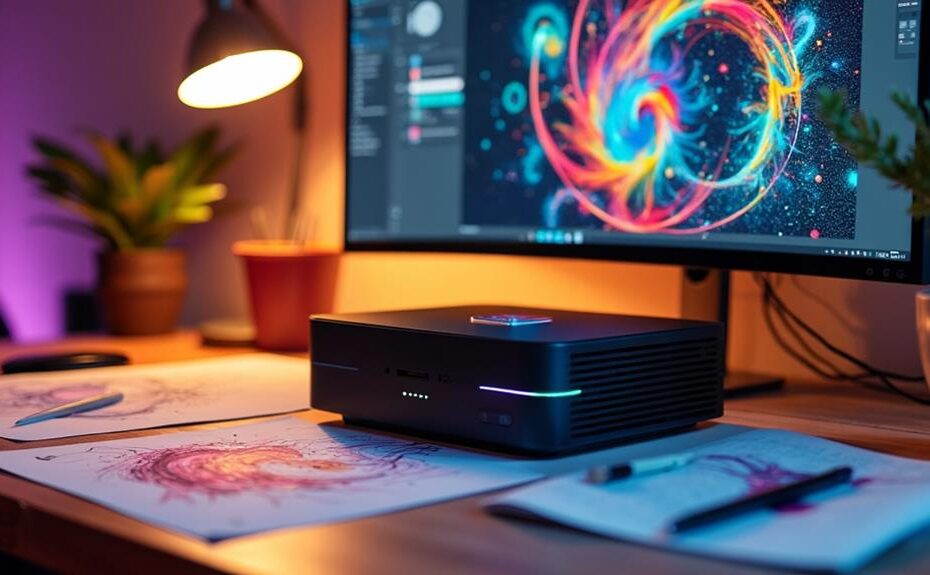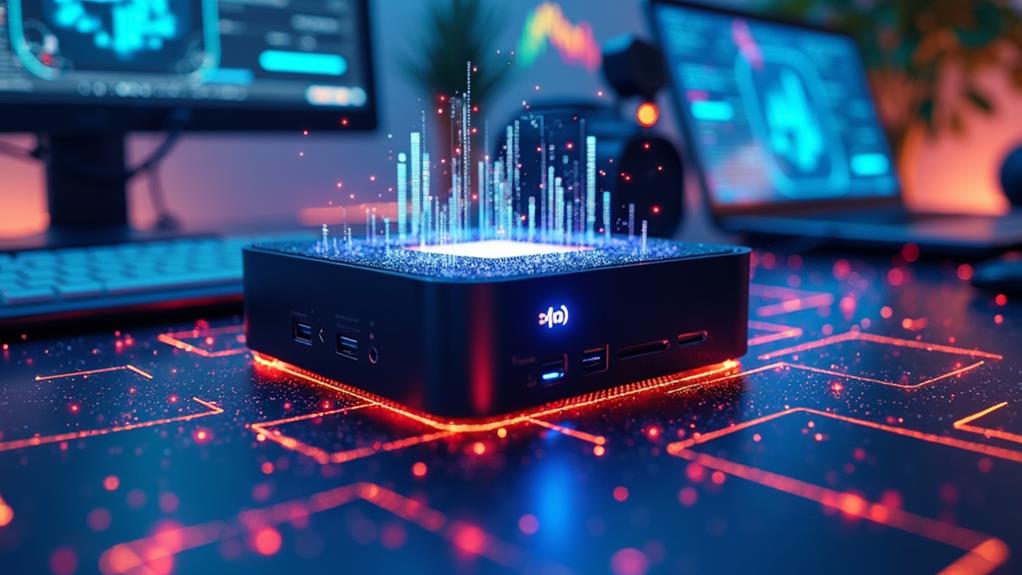



A Mini PC can handle advanced animation software, but performance greatly depends on its specifications. For best results, you need a model with a dedicated graphics card, ideally an Nvidia RTX 3060 or equivalent. Integrated graphics fall short for complex rendering tasks. While Mini PCs can manage basic animations, they often lag behind laptops in thermal management and overall speed. External GPU setups can boost performance but come with compatibility issues. If you're considering a Mini PC for animation, weighing your options carefully is essential. Discovering the most suitable choice can enhance your animation experience remarkably.
Key Takeaways
- Mini PCs can manage basic animation tasks, but advanced software often requires more powerful hardware than they typically offer.
- A dedicated GPU, ideally Nvidia RTX 3060 or equivalent, is crucial for optimal performance in advanced animation applications.
- Limited integrated graphics in Mini PCs may struggle with complex rendering tasks, necessitating a dedicated graphics card for efficiency.
- External GPU setups can enhance Mini PC performance, but compatibility and connectivity issues may arise, particularly with AMD-based models.
- Overall, Mini PCs lack the upgradeability and thermal management of laptops, which are better suited for demanding animation workloads.
Mini PC Specifications Overview
When considering a Mini PC for animation, you'll want to pay close attention to its specifications. The CPU is a critical component; look for models featuring compact processors like the Ryzen 7 5880H or Ryzen 9 7940HS, which provide adequate power for basic animation tasks. The performance and specifications of the Mini PC you're evaluating will heavily influence its capability to handle demanding software. However, if you're using advanced animation software like Blender, integrated graphics options such as the Radeon Vega 8 may struggle with complex rendering. This is where a dedicated graphics card becomes essential.
Many Mini PCs lack support for external GPUs (eGPUs), which can limit high-end graphics capabilities unless they're equipped with Thunderbolt connections. For GPU-accelerated rendering, consider a Mini PC with at least an RTX 3060 or an equivalent GPU to guarantee a smooth experience.
Performance Comparison With Laptops
While Mini PCs can handle basic animation tasks, they often lag behind laptops in performance, particularly for demanding applications like Blender. When you're looking for a laptop for animation, the graphics cards play a vital role. Performance metrics and benchmarks are essential for evaluating a system's capability, and laptops typically integrate high-end GPUs, essential for efficiently rendering complex scenes, whereas Mini PCs may struggle with GPU-accelerated tasks unless they sport a dedicated graphics card.
For a smooth experience in Blender, a Mini PC ideally requires at least an RTX 3060 or an equivalent GPU. However, even with similar specs, laptops often outperform Mini PCs due to superior thermal management. This allows laptops to maintain performance over longer rendering sessions without overheating.
Moreover, while high-performance Mini PCs can be cost-effective, they often lack the upgradeability options many laptops provide, limiting your ability to enhance performance in the long run. Portability is another key advantage of laptops; they let you animate on-the-go, unlike Mini PCs, which generally need a stationary setup. This performance comparison highlights that if you're serious about animation, a laptop may offer the best blend of power and flexibility.
GPU Requirements for Animation
A dedicated graphics card (GPU) is essential for achieving ideal performance in animation software. Advanced animation applications typically demand a dedicated GPU with at least 4GB of VRAM to handle rendering tasks and complex graphics effectively. The powerful AMD Ryzen 5 5560U CPU found in systems like the Beelink SER5 Mini PC can support integrated graphics but may struggle with demanding GPU-accelerated processes found in programs like Blender, making a dedicated graphics card vital for more intricate projects.
For peak performance, consider GPUs like Nvidia's RTX series, which are designed to support real-time ray tracing and accelerated rendering. These features greatly enhance your ability to create detailed animations quickly and efficiently. The minimum GPU specification for a comfortable experience usually includes models such as the Nvidia RTX 3060 or equivalent, which provide the necessary power for efficient rendering and playback.
External GPU Options
The flexibility of external GPU (eGPU) options opens new avenues for Mini PC users aiming to enhance their animation capabilities. Since Mini PCs typically lack dedicated GPU power, integrating an eGPU becomes vital for running advanced animation software effectively. For Intel-based Mini PCs, Thunderbolt connectivity is critical for eGPU support, allowing you to connect high-performance graphics cards like the NVIDIA GeForce RTX 3060 or better. However, most AMD-based Mini PCs face compatibility limitations, restricting eGPU usage.
Utilizing an eGPU can greatly boost your rendering performance, enabling you to tackle demanding animation tasks with ease. Performance comparisons indicate that Mini PCs with eGPUs can match or even surpass standalone desktops regarding rendering power. However, it's important to take into account the drawbacks, such as higher costs and the increased complexity of setup and compatibility.
Ultimately, while an external GPU can greatly enhance your Mini PC's animation capabilities, careful evaluation of cost versus performance is vital to guarantee that you're making a worthwhile investment. By weighing these factors, you can choose the right setup to bring your creative visions to life.
User Experiences and Insights
User experiences reveal a mixed bag when it comes to using Mini PCs for animation tasks. Many users report success with basic 3D modeling and CPU-based rendering using models equipped with AMD Ryzen 7 CPUs. These systems can handle less demanding animation software without much trouble. However, when it comes to GPU-accelerated rendering, the feedback shifts dramatically. Advanced animation software like Blender often requires at least an RTX 3060 or equivalent GPU for a smoother experience, and many Mini PCs simply fall short.
Users frequently encounter performance bottlenecks when tackling complex scenes due to limited GPU power and reliance on integrated graphics. This limitation becomes a considerable drawback for those aiming to produce professional-grade work. Additionally, the importance of balancing performance-per-dollar becomes clear; opting for cheaper Mini PCs may lead to unmet demands of more sophisticated animation projects.
Recommendations for Best Mini PCs
Considering the demanding nature of animation tasks, selecting the right Mini PC can greatly impact your workflow and output quality. If you're serious about animation, you'll want a Mini PC that features a powerful dedicated graphics card. While options like the Mini PC with AMD Ryzen 9 7940HS CPU and Radeon 780M GPU can handle basic tasks, they may struggle with GPU-accelerated rendering in advanced software like Blender.
For peak performance, aim for a Mini PC equipped with at least an RTX 3060 or an equivalent dedicated GPU. This will make a significant difference when managing high-demand rendering tasks. Remember, the performance of Mini PCs often hinges on integrated graphics, which can fall short for complex projects.
If you're looking for greater performance and expandability, consider building a Mini-ITX PC. This setup allows you to integrate a dedicated graphics card, providing a better balance of power and size for your animation needs. Keep in mind that Mini PCs generally offer limited upgradability compared to traditional desktops, so invest wisely to guarantee your Mini PC can keep up with evolving software requirements.
Disclosure: As an Amazon Associate, I earn from qualifying purchases.




